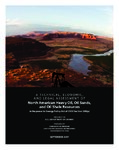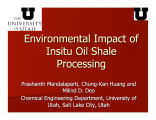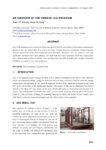TO
Filters: Collection: "ir_eua"
1 - 25 of 15
| Title | Date | Subject | Description | ||
|---|---|---|---|---|---|
| 1 |
 | Coal devolatilization at very slow heating rates | 2007 | coal devolatilization ; slow heating rates; volatiles; coal; devolatilization temperatures; volatile yeilds; atmospheric gases | The yield of volatiles of liquid and gaseous species is a function of operational conditions, including effects of reactor atmosphere gases, coal ranks, heating rates, ultimate devolatilization temperatures, pressure, soak time at ultimate temperatures, and catalysts. One important factor of coal de... |
| 2 |
 | Effect of ethanol on the chemical structure of the soot extractable material of an ethylene inverse diffusion flame | 2007 | Soot extractable material; Ethylene inversion diffusion flame; Aromatic fused rings; Neat flame; Chloroform-extractable material; Aliphatic component; Incomplete combustion; Fossil fuels; Ethanol; Soot; Emission; Soot particles; Polyaromatic hydrocarbons; Potential carcinogen | The effect of fuel-side ethanol addition on the chemical structure of the soot extractable material generated in an ethylene inverse diffusion flame was evaluated by means of average structural parameters. The results indicate that the ethanol effect on the aromatic components was more pronounced, w... |
| 3 |
 | Experimental evaluation of the effects of quench rate and quartz surface area on homogeneous mercury oxidation | 2007 | quench rate; quartz surface area; homogeneous mercury oxidation; mercury chemistry | This paper presents a mercury oxidation data set suitable for validation of fundamental kinetic models of mercury chemistry and for mechanism development. Experimental facilities include a mercury reactor fitted with a 300-W, quartz-glass burner and a quartz reaction chamber. While operated with a t... |
| 4 |
 | Productivity, screens, and aspect ratios | 2007 | Computer display performance; Computer display usability | Questions revolving around computer screen display configurations and capabilities have been raised within industry since the introduction of the color computer display in the mid- 1980s. Each innovation has added new questions about the effect of display attributes on productivity. Today's display ... |
| 5 |
 | Resolution on scholarly communication | 2007 | Scholarly communication; publishing; open access | Resolution presented to the Academic Senate at The University of Utah by Mary Youngkin on March 5, 2007. |
| 6 |
 | A technical, economic, and legal assessment of North American heavy oil, oil sands, and oil shale resources: In response to Energy Policy Act of 2005 Section 369(p) | 2007-09 | Oil sands; Oil shale; Heavy oil; Energy Policy Act; 2005; Climate Change; Petroleum; Oil Cost; United States; North American heavy oil; Utah Heavy Oil Program; UHOP; World economic development; Energy; Canadian oil sands; Unconventional resources ;Technical; Economic; Legal assessment | Against the backdrop of world population growth, rapid economic expansion in the world's most populous countries, challenging political climates in many oil-producing nations, and the specter of climate change, worldwide energy consumption is projected to increase from the 2004 level of just over 40... |
| 7 |
 | America's strategic unconventional fuels: Oil shale, tar sands, coal derived liquids, heavy oil, CO2 enhanced recovery and storage | 2007-09 | Colorado; Wyoming; Oil shale development; In-situ; Environmental impacts; Water supply issues; Economics; Socio-ecomonic impacts; Infrastructure; Market challenges; Programmatic Environmental Impact Statement; PEIS; RD&D; BLM; Leasing program; Federal lands; Oil Shale Program Plan; Energy Policy Act | The Task Force members from Colorado and Wyoming have expressed legitimate concerns about the timing and sequence of Federal efforts to promulgate commercial leasing regulations for oil shale development and initiate leasing activity. They are concerned that the current state of development of surfa... |
| 8 |
 | Climate change 2007: The physical science basis--summary for policymakers | 2007-02 | Climate change; Greenhouse gases; Aerosols; Solar radiation; Radiative forcing; Third Assessment Report; TAR; Solar activity; Carbon dioxide; CO2; Methane; CH4; Nitrous oxide; N2O; Fossil Fuel; Land use; Agriculture; Land surface properties; Warming; Melting of snow and ice; Rising seal level; Globa... | The Working Group I contribution to the IPCC Fourth Assessment Report describes progress in understanding of the human and natural drivers of climate change1, observed climate change, climate processes and attribution, and estimates of projected future climate change. It builds upon past IPCC assess... |
| 9 |
 | Environmental impact of in-situ oil shale processing | 2007-10 | in situ processing of oil shale; in situ processing; oil shale; production of oil from kerogen; oil production | The in situ processing of oil shale for the production of oil from the kerogen involves heating the shale slowly to moderate temperatures of between 3000 C and 4000 C. At this temperature, gaseous products that evolve from the oil shale are condensed and recovered. The pathways of creation of oil fr... |
| 10 |
 | In-situ production of Utah oil sands bitumen | 2007-11 | in situ production; Utah oil sands; Utah reservoirs; in situ bitumen production; SAGD; case studies | In-situ production of oil-sand bitumen offers an excellent alternative to the ex situ processes that are based on strip-mining and surface extraction. In addition to leaving the landscape relatively undisturbed, in situ processes allow for partial upgrading of oil sands, leaving heavier, less profit... |
| 11 |
 | Production of oil shale from the Green River Formation in Utah | 2007-11 | oil shale; oil shale production; Green River formation. | The largest deposits of oil shale in the world are documented to be in the Green River Formation of western United States. If this oil resource (conservative estimate of 800 billion barrels recoverable) could be used to meet a quarter of the present U.S. demand for petroleum products, the resource w... |
| 12 |
 | Secure fuels from domestic resources: The continuing evolution of America's oil shale and tar sands industries | 2007-06 | secure fuels; domestic fuel; energy security; foreign imports; oil; oil conservation; fuel conservation; domestic fuel; bio-fuels. | Energy security is essential to preserve America's economic strength and national security. Reducing our dependence on foreign imports of oil and refined products is essential to achieving the energy security objective. Import reductions can be achieved in two fundamental ways--reducing our demand f... |
| 13 |
 | 42nd Annual Leary Lecture: Preliminary Thoughts on Copyright Reform | 2007-10-18 | copyright; intellectual property; reform; leary; samuelson | Professor Samuelson is a fellow of the Association for Computing Machinery, a contributing editor of communications of the Association of Computing Machinery, a past fellow of the John D. and Catherine T. MacArthur Foundation, and an honorary professor at the University of Amsterdam. A graduate of t... |
| 14 |
 | An overview of the Chinese UCG program | 2007-08-11 | Coal; China; Underground Coal Gasification; UCG; Two-stage gasification; Chinese UCG program; Energy | Coal is the dominant source of energy in China, but about 50% of the coal resource is left underground unmined. Because of this, the "long-tunnel, large section, two-stage" Underground Coal Gasification (UCG) technology has been put forward, and the UCG model platform has been built. Simulation test... |
| 15 |
 | Evaluation of Blue Blocking Intraoculalr Lenses Including a New Photochromatic IOL | 2007-03-14 | Blue Blocking; Yellow IOL; Photochromatic IOL; Night Vision; Macular Degeneration | This movie introduces photochromatic IOLs and compares them to blue blocking IOLs. It discusses the benefits photochromatic IOLs provide such as improved night vision and protection of the macula. |
1 - 25 of 15
